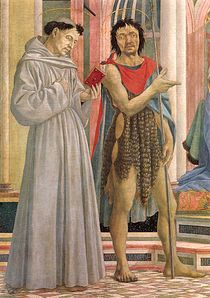Domenico Veneziano
Domenico Veneziano (c. 1410 – May 15, 1461) was an Italian painter of the early Renaissance, active mostly in Perugia and Tuscany.

Little is known of his birth, though he is thought to have been born in Venice, hence his last name. He then moved to Florence in 1422–23 as a boy, to become a pupil of Gentile da Fabriano. He is said to have worked with Pisanello in Rome around 1423–1430. His work was influenced by the style of Benozzo Gozzoli.
In a letter from him to
Other important works are the Madonna del Roseto in the National Museum of Art of Romania and the Madonna Berenson in the Villa I Tatti in Florence, both dating to around 1432–1437.
He worked at the decorations of the Portinari chapel in the hospital of Santa Maria Nuova in Florence from 1439–1445, and had as his assistants Piero della Francesca and Bicci di Lorenzo. It is certain that whilst employed there he used linseed oil as his medium, since the hospital books of that date make many allusions to this item in his expenses. His latter days were spent in Florence, where he died on May 15, 1461.
Predella of the Santa Lucia de' Magnoli Altarpiece

|

|

|

|

|
Left to right:
| ||||
The
| External videos | |
|---|---|
 | |
References
- ^ "Veneziano's St. Lucy Altarpiece". Smarthistory at Khan Academy. Retrieved October 8, 2013.
- Bryan, Michael (1889). Walter Armstrong; Robert Edmund Graves (eds.). Dictionary of Painters and Engravers, Biographical and Critical. Vol. II L–Z. London: George Bell and Sons. p. 652.
External links
![]() Media related to Domenico Veneziano at Wikimedia Commons
Media related to Domenico Veneziano at Wikimedia Commons
